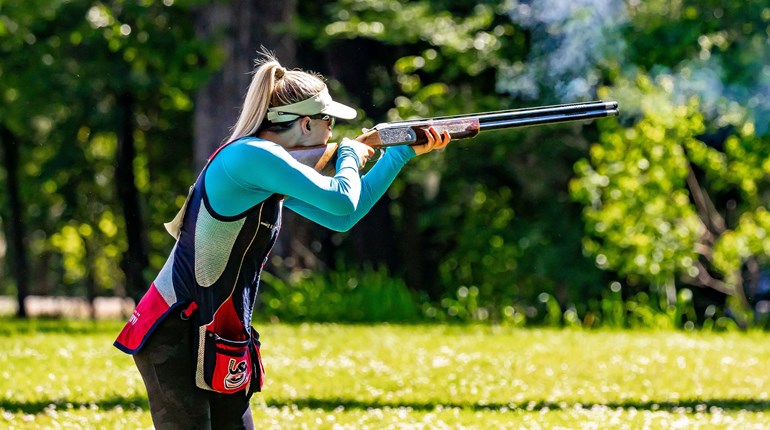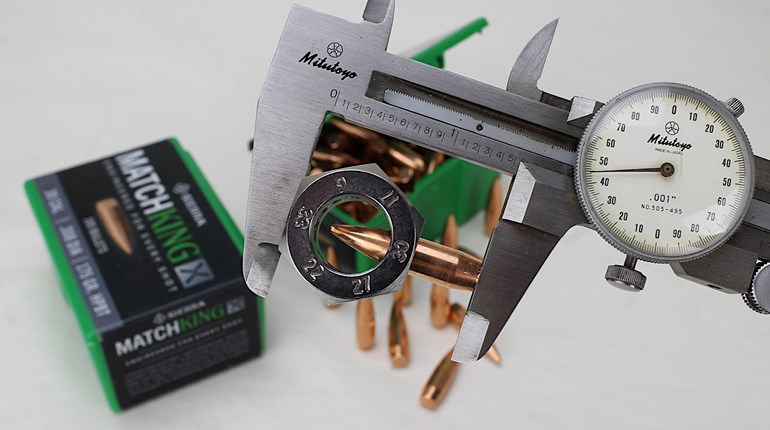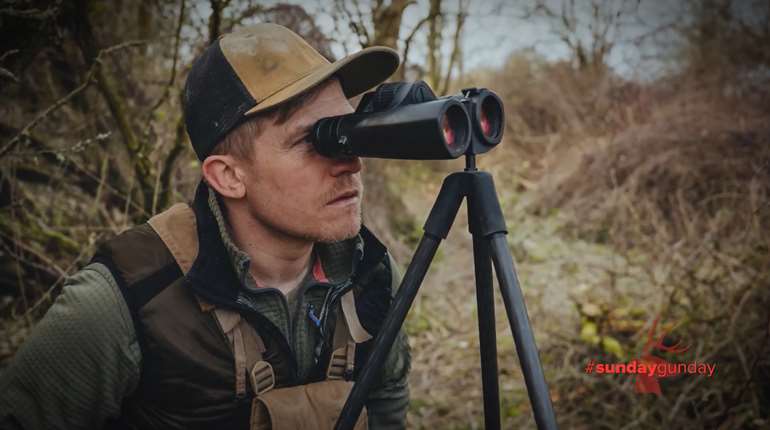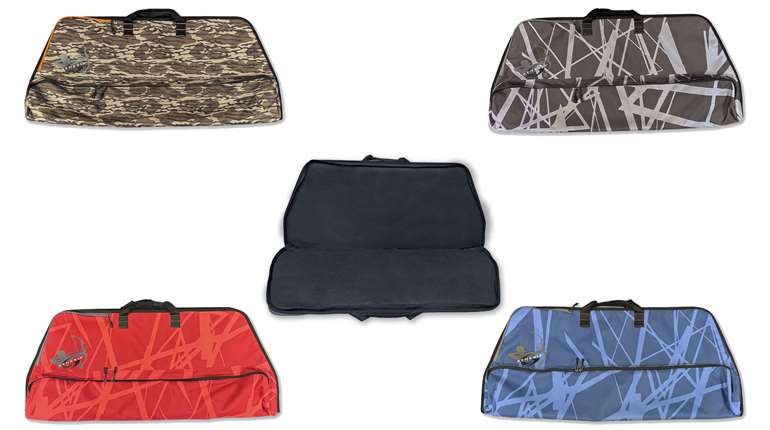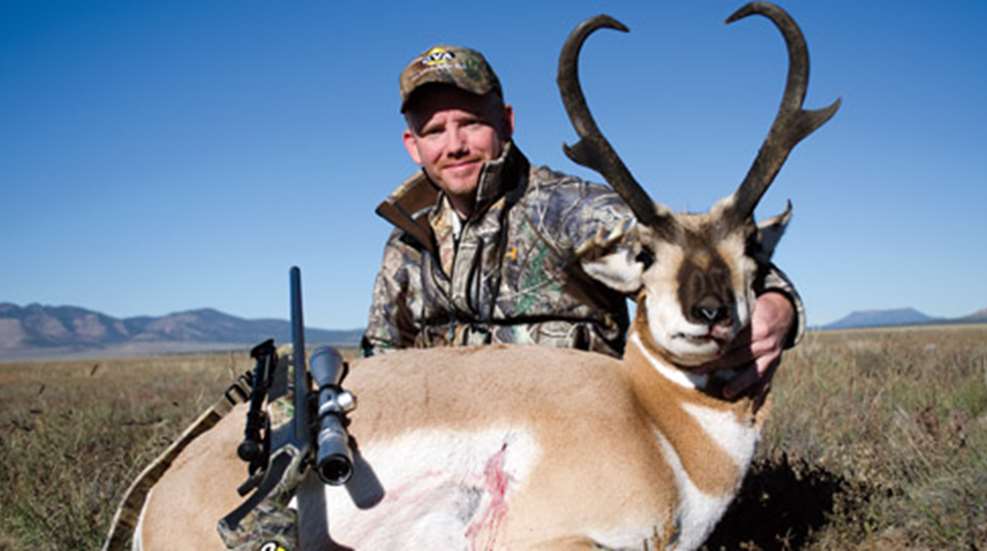
Scattered across the Plains of San Augustin were white-and-tan dots we knew were antelope. Beyond the antelope were the foothills of the rugged Mogollon Mountains, giving this massive New Mexico basin perspective. Whereas in the deserts in the Southwest there are places so flat they stretch like calm seas to the horizon, this basin’s distant mountains give context to the proportions of Earth. So as I stood there feeling like a speck on the grassy plain I couldn’t help repeating ballistic charts in my head.
Maybe Van Hale, owner of Trophy Outfitters, saw the words in my eyes, because as we knelt behind bitterbrush to glass, he said, “This place is made for riflemen.”
Then, right on cue, a buck 400 yards away trotted out of a sway in the terrain as if he knew it was time for the star of the wide-screen production to make his entrance.
Van said right away, “Oh my, you’re gonna have to shoot this buck.”
All I thought was: So soon? After all, shouldn’t a hunt take at least as long as the flight to get there? Of course, I knew better. No one pities the guy who let the big one get away.
Van ranged the buck and said, “411 yards.” He then squinted at my rifle.
I knew what he was thinking. Some fishermen try to land 80-pound tarpon on 10-pound line. One likeable nut I let fade into my past goes after New England’s ruffed grouse by quick-drawing a sawed-off, double-barreled 20-gauge with the stock cut off at the pistol grip (he had to get a handgun permit for the contraption). I hadn’t done anything as extreme as all that. I’d just taken a light, single-shot CVA Apex chambered in .270 Winchester to antelope country.
The .270 Winchester, of course, has long been the standard of comparison for long-range hunting cartridges. I was using ammo from the Bitteroot Valley Ammo Company loaded with 130-grain Speer Grand Slam bullets. I topped the CVA with a 3x-10x-44mm Konus scope and attached a Harris bipod. Sure, this isn’t a setup that would impress a long-range aficionado, but I didn’t think of it as a handicap.
“These little CVAs shoot,” I said, still kneeling behind bitterbrush.
Van glanced at me and said, “My .300 Weatherby could kill that goat. It’s a heavy rifle and a flat-shooting son-of-a-gun.”
I grinned as I opened the Harris bipod. Van is a good hunter. He’s been guiding since 1982. In all that time I have no doubt he has seen his share of guys miss with deer rifles sighted in back East. But I’ve been to CVA’s Bergara factory in Spain. It’s one of those factories with bright CNC machines humming along and busy engineers with serious expressions who don’t even smile when they tell you their rifle barrels are cut to variances inside one-ten-thousandth of an inch.
Yeah, CVA’s quality control impressed me. Then its rifles did. CVA’s single-shots are ergonomic, they have good, adjustable triggers and, in my experience, they’re accurate. I hadn’t settled this particular rifle down on a bench. I’d only used it to shoot a few five-shot groups at 100 yards off feedbags set atop a rickety pop-up table. But even so all the bullets hit within 2 inches of each other. Also, its adjustable trigger was set for 3 pounds and was crisp and I knew the ballistics of the .270. So I felt very comfortable with this gun out to 400 yards—provided the wind wasn’t extreme and I could go prone or settle it down on my pack.
But before I even got behind the trigger, Van was cursing. Not at me. The buck had started to run.
I hid my pleasure. I wanted to hunt and then to shoot well. I didn’t just want to prove I could shoot.
On the Trail of a Giant
Dust plumed into the early sun behind the antelope and then the buck dropped into a ditch. These big, dusty expanses are deceivingly flat—deceiving because they aren’t flat at all. Ditches, ravines, brush and rolling ground hides a lot of terrain.
We strode after him across the ruddy plain. Ten minutes later the buck trotted out of a dry streambed a half-mile west. The antelope hadn’t been spooked, not really. He was rutting. He’d just spotted a herd and decided to go to them, at antelope speed. The buck began sniffing a group of two dozen pronghorn.
We scrambled into a dry streambed, followed it for a quarter-mile and peeked up onto the hillside where we’d last seen the buck. He wasn’t there. We started carving up the terrain with our binoculars. We moved and glassed as the sun rose and it got hot. We could see the does he’d sniffed and some smaller bucks.
Finally, as we came out of another ravine, we saw him as he walked the crest of a distant rise all distorted by the rising heat waves. I can still see the buck’s horns silhouetted and looking absurdly big.
It was early October and the rut was winding down. Only a few bucks were still this active. Perhaps this buck had bred all the does in his harem. Or maybe he’d lost his does to a younger buck, an animal that hadn’t worn itself out in the rut. Whatever the reason, he was hunting for more action and we had to get in front of him.
As we had no way of knowing how far he’d go we opted to head back to the truck and drive around.
We stopped and glassed where we thought the buck should be. After another hour we found him. He was at the edge of the ranch skirting a housing development built against foothills. We left the truck and marched off to intercept him.
We made good time cutting across the grassland for a half-mile, but then topped a rise and were blocked by dozens of antelope feeding along a fence line. If we bumped these they’d surely spook the big buck somewhere beyond them.
We circled downwind. Though this was a private-land lease these antelope had been pressured. This is because New Mexico has a unique public-land access program. Biologists set the number of tags for each unit and then allocate them to ranches and public areas. To get the tags, ranchers also have to agree to allow non-paying hunters. The state gives out as many landowner tags as they do public-draw tags for which the general public (residents and nonresidents) can apply. It’s a low-odds draw, but New Mexico doesn’t have a preference-point system for these tags; as a result, with a little money and a dream you can try to draw a hunt in an area where you have a legitimate chance of shooting an antelope that’ll make the Boone & Crockett Club records book.
Kevin Rodden, the deer and pronghorn biologist for the New Mexico Department of Wildlife, said, “We’re trying to get the right balance with antelope tags to hunters. Right now I don’t think we’re issuing enough tags for every unit. The hunting, of course, is high quality because the pressure is generally low, but we’re trying to determine how many more tags we can issue before the quality diminishes. That’s a difficult calculation, as we also have to take winter kill and other factors into consideration, but right now I’d say we can offer a few more tags.”
As a few of the lucky hunters who’d drawn tags had already hunted these antelope, they were skittish. That didn’t bother me. I wanted this to be a hunt, not a shoot.
Van felt that way, too. Except one hunter had followed him around, figuring Van knew where all the monsters hid. “That guy really bugged me, but then I let him follow me to places I’d never seen a good buck,” he told me with a chuckle.
A few minutes later we were moving through cedars and sage with our backs bent when I spotted antelope horns 40 yards to our right.
I whistled, but stayed bent. Van stopped and followed my eyes. The goat was looking at us with this confused expression antelope are masters of—something about their bulging eyes lets them pull off bewilderment particularly well. He knew something wasn’t right.
We also knew something wasn’t right. The goat was big—maybe 15 inches tall and heavy—but it wasn’t the goat.
It barked and sprinted away and we spent the rest of the day hiking and glassing. Finally, when the sun was setting, giving the plains this orange color that reminded me of classic Westerns shot in Technicolor, we spotted our buck crossing a road, but it was too late to pursue.
Another Day in Paradise
The next morning we started where we’d left off. After an hour we spotted him a mile away. The buck was moving as usual.
We followed, but the ground was wide open. We couldn’t get closer than 600 yards in ankle-high grass. Two hours and a half-mile later we were under the only tree for hundreds of yards. The buck was with 30 or so antelope spread out along a fence line. He was trotting back and forth threatening all the other bucks and sniffing the does.
“I should have brought the decoy,” said Van. “With the Montana Decoy we could have tried to get within 400 yards.”
Then a herd came from behind and almost stampeded us. An estrous doe in this new herd had that jerky, stop-and-go run whitetail does get when they’re going into heat. Two 14-inch bucks started fighting right in front of us.
This got the old boy interested. He trotted closer. It looked like he might come all the way, but then the doe tore down the expanse with the two bucks chasing.
“Come on,” said Van.
We bent over and went single-file right after them. The doe was distracting the antelope, so we just took a chance. At 450 yards, the antelope noticed us. We lay down in the grass. I opened the bipod.
As soon I did that old buck circled our way to keep the two bucks that had been fighting away from the doe.
“Three-eighty … 370 … 360,” called out Van, making me think, good guide.
The buck stopped. The wind was right-to-left at about 5 mph, which gave me a wind drift of about 3-4 inches. At 400 yards the 130-grain Speer Grand Slams I was shooting were dropping a touch over 20 inches (given that the scope was set dead-on at 200 yards). All the guesswork in my calculations was well inside the margin of error (the size of the antelope’s vitals) and I had a solid rest. So I held 15 inches high and 4 inches right and touched off that little CVA.
The antelope didn’t even flinch.
Van hissed, “Shoot again.”
Now, I was holding a single-shot .270 and lying prone in foot-high grass. I could see dust rising from 30-plus antelope running. One of them was the giant buck. Even if I could reload fast enough there was no chance to get on the buck in all that. The thought ran through my mind and I decided that shooting again was so hopeless I might as well be cocky, so I just said, “Why?”
Van scowled at me. When not outfitting in the Southwest he charters out of Mexico for marlin. He has the salty captain’s expression of hard disdain perfected. But before he could back up the frown with some dry retort befitting the landscape, the buck fell.
Van’s expression lightened.
The buck green-scored 86 on the B&C scale—beating the club’s minimum of 80. It takes some luck and time to pull down a tag in this rifleman’s paradise. It takes a discerning eye and patience to hunt down its trophy antelope. And, for some, it’ll take time at the range to increase how far they can ethically shoot. But the B&C bucks are there and tags are drawn each year.














